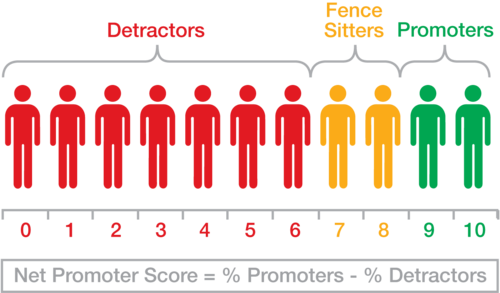Today we’re sharing insight from guest blogger Andrew Berlin, Chairman & CEO of Chicago-based Berlin Packaging, Chairman & Owner of the South Bend Cubs, and a Partner Owner of the Chicago Cubs. We hope you enjoy Andrew’s wisdom and perspective.
My goal isn't to satisfy customers; I want to thrill them. I’m not just being nice – I know this is good for business. A great way to measure how you're connecting with customers is through Net Promoter.
Net Promoter is a way to measure customer engagement and loyalty. There are two basic pieces to the approach.
Part One – The Score
Net Promoter is a score that is the result of asking one question to your customers and prospective customers: On a scale of 0 to 10, how likely are you to recommend [company x] to a friend or colleague?

The Net Promoter is calculated as: The percent of respondents that score you a 9 or a 10 (these are the “Promoters”) minus the percent of respondents that score you a 0 to 6 (these are the “Detractors”). For the score calculation, you ignore the respondents that score you a 7 or 8.
Essentially, after Promoters cancel out any Detractors, how many Promoters are left over to evangelize about your company? The resulting score is between -100% and +100%.
This number is useful because research has shown a direct correlation, across industries, between companies with a higher Net Promoter and companies that are more successful financially. Their revenue grows faster, for example.
It’s also useful since it’s so easy to collect – a very simple survey, which increases response rates – and the score can be dissected by region, business unit, or salesperson. You can dig in to find pockets of strength and weakness very easily.
Part Two – The Why
In addition to asking “would you recommend,” you also want to ask respondents why they feel that way. This uncovers tremendous insights into what customers value and what customers actually experience today.
This should also be used to enhance the customer experience. Companies should consider all the “touchpoints” customers have with an organization and objectively examine what happens to customers and how that relates to what customers want. Each customer interaction yields either an improvement or a reduction in the likelihood of a customer recommending your company.
Each touchpoint should be optimized to not only satisfy customers, but to thrill them. To do this, you truly need to understand the wants and needs of customers.
I’ve taken these ideas and embraced them at Berlin Packaging, where I see our approach to the customer experience as a true competitive advantage. We spend more time thinking about, improving, and delivering against the customer experience than any other company in our sector. And we have great results in Net Promoter, our score is tops in the industry, and financially we are growing 10x the rate of the industry.
I've also applied Net Promoter to the South Bend Cubs. We looked at every touchpoint a ballpark visitor has – from driving to the field and parking to listening to the music and eating our food. We try to inject thrill into every part of a visit. Last season, 89% of fans would highly recommend a trip to see the South Bend Cubs – more than twice what we saw in 2011 when I purchased the team.
What's The Risk?
Ignoring the customer experience puts your business in peril. Conversely, smart companies pay close attention to enhancing the customer experience. We know thrilled customers are going to give us more of their wallet, stay with us longer, and promote us to prospects and, thus, making our acquisition efforts easier.
Net Promoter is a useful and easy tool that, when paired with leadership focus, can drive powerful change across the organization. The best companies can use this approach to build a true advantage against competitors.
You can learn more about Net Promoter at www.CustomerThrill.com.
This content was written and shared by guest blogger, Andrew Berlin.
 Andrew Berlin is the Chairman and Chief Executive Officer of Chicago-based Berlin Packaging. He has led the company for 29 years – taking it from a small distributor to a true juggernaut in the packaging industry. The company was recently valued at $2.3 billion and is a global supplier of plastic, glass, and metal containers and closures. Berlin Packaging serves customers of all types, of all sizes, across all industries, including personal care, pharmaceutical, chemical, food, and beverage.
Andrew Berlin is the Chairman and Chief Executive Officer of Chicago-based Berlin Packaging. He has led the company for 29 years – taking it from a small distributor to a true juggernaut in the packaging industry. The company was recently valued at $2.3 billion and is a global supplier of plastic, glass, and metal containers and closures. Berlin Packaging serves customers of all types, of all sizes, across all industries, including personal care, pharmaceutical, chemical, food, and beverage.
Andrew is a Partner Owner of the World Champion Chicago Cubs. He is also the Chairman and Owner of the South Bend Cubs, the minor league affiliate of the Chicago Cubs. Since he purchased the team in 2011, he revitalized the team to set new standards of excellence in baseball, including receiving the John H. Johnson award as the best team across all of Minor League Baseball.
Andrew has a passion for business and has seen how a smart focus on culture can yield extraordinary results. You can learn more about him at www.AndrewBerlin.com.



